PVSG exhibit walk-thru
3 posters
Page 1 of 1
 PVSG exhibit walk-thru
PVSG exhibit walk-thru
Feb. 22 (1:00-4:00 p.m):
Potomac Viewing Stone Group will meet in the Yoshimura Center, National Bonsai & Penjing Museum (US Natl Arboretum) in Washington DC. Members will discuss recent stone exhibits, including a walk-thru of the currently-mounted PVSG exhibit titled "Winter Anticipating Spring." Discussion will include reasoning behind the decisions made during its set-up. At 4 p.m. that exhibit will be taken down by members. Visitors are invited to participate.
Bamboo & Plum stones, Pine cone kogo "incense container:" Three Friends of Winter (Chinese allusion)
... Sorry, all photos were taken before set-up was completed including distribution of tags, lighting adjustment et al.
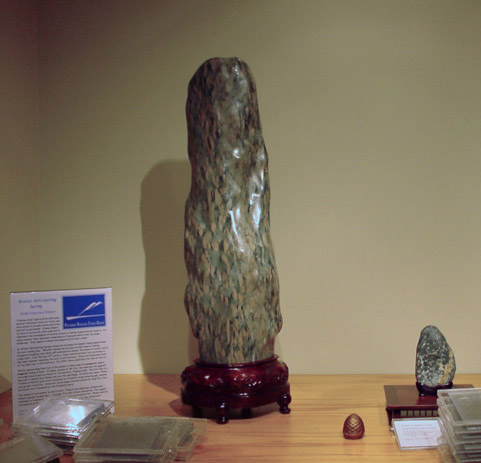
First Sunrise (Hatsu-hinode) stone: Dreaming of Sun Rising Over the Sea

Turtle stone: a token of longevity
"May you thrive for a thousand years!"
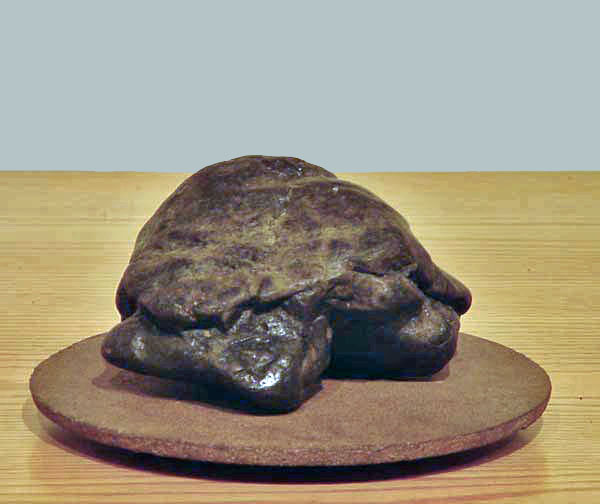
Potomac Viewing Stone Group will meet in the Yoshimura Center, National Bonsai & Penjing Museum (US Natl Arboretum) in Washington DC. Members will discuss recent stone exhibits, including a walk-thru of the currently-mounted PVSG exhibit titled "Winter Anticipating Spring." Discussion will include reasoning behind the decisions made during its set-up. At 4 p.m. that exhibit will be taken down by members. Visitors are invited to participate.
Bamboo & Plum stones, Pine cone kogo "incense container:" Three Friends of Winter (Chinese allusion)
... Sorry, all photos were taken before set-up was completed including distribution of tags, lighting adjustment et al.

First Sunrise (Hatsu-hinode) stone: Dreaming of Sun Rising Over the Sea

Turtle stone: a token of longevity
"May you thrive for a thousand years!"

Last edited by Chris Cochrane on Tue Jan 12, 2016 12:37 am; edited 5 times in total

Chris Cochrane- Member
 Re: PVSG exhibit walk-thru
Re: PVSG exhibit walk-thru
You can see a small poster describing the exhibit in the first photo of the previous post along with hang tags that need to be distributed among ~30 arrangements. Multi-tier arrangements each had several small stones. The mini-poster notes:
Winter Anticipating Spring: PVSG Collectors' Exhibit
"Viewing stone" appreciation embraces several traditional Asian art
forms and has evolved to include stones and stone aesthetics
worldwide. Stones shaped by nature are often selected to represent
the atmosphere of natural scenes or feeling toward natural objects.
For some viewers, they represent compression of energies which form
the larger landscape. Their appeal is unique and subjective for each
viewer.
In "Winter Anticipating Spring," stones are arranged to request
rising expectations for your coming year. Whether leaving the old
year to start anew or looking forward to budding color while still
enveloped by winter, the season of winter offers a new start. Until
the late 19th century, Japan celebrated New Year according to the
lunar calendar beginning the year in mid-February. China still
celebrates start of the New Year in mid-February. For 2009, China
celebrates the Year of the Ox.
Winter approaching New Year is the season to share hope for
prosperity, luck & longevity among friends. In Japan, dreams of Mt.
Fuji, the hawk and the eggplant are auspicious as well as dreams of
the bountiful Treasure Ship. The Rising Sun over the Sea image
implicitly expresses the first day of a new year. From China, Three
Friends of Winter (pine, plum & bamboo) as well as the Three
Auspicious Fruits (the "Buddha's Hand" citron, peach & pomegranate)
suggest renewal of expectations. Turtle and crane images express long-
life.
The season of mid-winter is cold & stark. Landscape trees, grasses
and bonsai express modest beauty through thin color & bare
silhouettes. The rugged loneliness of seashores and snow-swept peaks
are particularly felt. Please feel the atmosphere of the winter
season sharing our eagerness for the coming year.
Join us… Share our passion... Imagine yourself in a mountain stream
or exploring a forested hollow-- perhaps, at a special personal place
known only to you-- where a fine stone lays waiting for your hand.
... END OF EXHIBIT POSTER ...
Mt. Fuji stone, Hawk carving
Lucky dream-- Fuji, hawk & eggplant

Cherry pattern/color stone, wood okimono
Spring flowering tree, "Year of the Ox (begins mid Feb. 2009)"
This arrangement was chosen for a large Museum poster created for the exhibit.

Winter Anticipating Spring: PVSG Collectors' Exhibit
"Viewing stone" appreciation embraces several traditional Asian art
forms and has evolved to include stones and stone aesthetics
worldwide. Stones shaped by nature are often selected to represent
the atmosphere of natural scenes or feeling toward natural objects.
For some viewers, they represent compression of energies which form
the larger landscape. Their appeal is unique and subjective for each
viewer.
In "Winter Anticipating Spring," stones are arranged to request
rising expectations for your coming year. Whether leaving the old
year to start anew or looking forward to budding color while still
enveloped by winter, the season of winter offers a new start. Until
the late 19th century, Japan celebrated New Year according to the
lunar calendar beginning the year in mid-February. China still
celebrates start of the New Year in mid-February. For 2009, China
celebrates the Year of the Ox.
Winter approaching New Year is the season to share hope for
prosperity, luck & longevity among friends. In Japan, dreams of Mt.
Fuji, the hawk and the eggplant are auspicious as well as dreams of
the bountiful Treasure Ship. The Rising Sun over the Sea image
implicitly expresses the first day of a new year. From China, Three
Friends of Winter (pine, plum & bamboo) as well as the Three
Auspicious Fruits (the "Buddha's Hand" citron, peach & pomegranate)
suggest renewal of expectations. Turtle and crane images express long-
life.
The season of mid-winter is cold & stark. Landscape trees, grasses
and bonsai express modest beauty through thin color & bare
silhouettes. The rugged loneliness of seashores and snow-swept peaks
are particularly felt. Please feel the atmosphere of the winter
season sharing our eagerness for the coming year.
Join us… Share our passion... Imagine yourself in a mountain stream
or exploring a forested hollow-- perhaps, at a special personal place
known only to you-- where a fine stone lays waiting for your hand.
... END OF EXHIBIT POSTER ...
Mt. Fuji stone, Hawk carving
Lucky dream-- Fuji, hawk & eggplant

Cherry pattern/color stone, wood okimono
Spring flowering tree, "Year of the Ox (begins mid Feb. 2009)"
This arrangement was chosen for a large Museum poster created for the exhibit.

Last edited by Chris Cochrane on Tue Jan 12, 2016 12:41 am; edited 1 time in total

Chris Cochrane- Member
 Re: PVSG exhibit walk-thru
Re: PVSG exhibit walk-thru
Root wood & stones-- individually & in arrangements (completing the first of three tables):
Dancer-- End of old year (bonenkai) & beginning of new year celebration
Daruma facing the cave wall

A Chinese "dream-stone"

Two exceptionally complementary stones creating a cove
 [img]
[img]
Bird figure stone, Winter streetscape woodblock print

Dancer-- End of old year (bonenkai) & beginning of new year celebration

Daruma facing the cave wall

A Chinese "dream-stone"

Two exceptionally complementary stones creating a cove
 [img]
[img]Bird figure stone, Winter streetscape woodblock print

Last edited by Chris Cochrane on Fri Jan 16, 2009 8:03 am; edited 2 times in total (Reason for editing : added objects/descriptions)

Chris Cochrane- Member
 Re: PVSG exhibit walk-thru
Re: PVSG exhibit walk-thru
Happy New Year Chris and Potomac Viewing Stone Group,
I'm extremely envious of this actively creative stone group who has the talent and means to mount an exhibition of this caliber. Having said this, I really hesitate to give critique of any weakness in a display...so I'll just point out what I really like with a few questions.
My favorite display is "Dreaming of Sun Over the Sea".....the sleeping figure is perfect with this stone. I also was "taken" with the bird figure and nontraditional display of woodblock winter street scene. The Mt. Fuji stone is wonderful but I'd like to see it in a larger flatter suiban...but perhaps this is a deep uncut stone ??
A question: in a recent juried show our bonsai club hosted, an exhibit of a large stone with scroll and small stone as accent was critiqued as nontraditional because of the choice of another stone as an accent. Is this a correct assessment ?
Thanks for showing us this exhibit ,Chris and I hope you can share some of the highlights of the display critique.
Norma
I'm extremely envious of this actively creative stone group who has the talent and means to mount an exhibition of this caliber. Having said this, I really hesitate to give critique of any weakness in a display...so I'll just point out what I really like with a few questions.
My favorite display is "Dreaming of Sun Over the Sea".....the sleeping figure is perfect with this stone. I also was "taken" with the bird figure and nontraditional display of woodblock winter street scene. The Mt. Fuji stone is wonderful but I'd like to see it in a larger flatter suiban...but perhaps this is a deep uncut stone ??
A question: in a recent juried show our bonsai club hosted, an exhibit of a large stone with scroll and small stone as accent was critiqued as nontraditional because of the choice of another stone as an accent. Is this a correct assessment ?
Thanks for showing us this exhibit ,Chris and I hope you can share some of the highlights of the display critique.
Norma

Norma- Member
 Winter Antcipating Spring/center table
Winter Antcipating Spring/center table
Mi Fu bowing to stone with snow in crevices, 2 stones & root stand
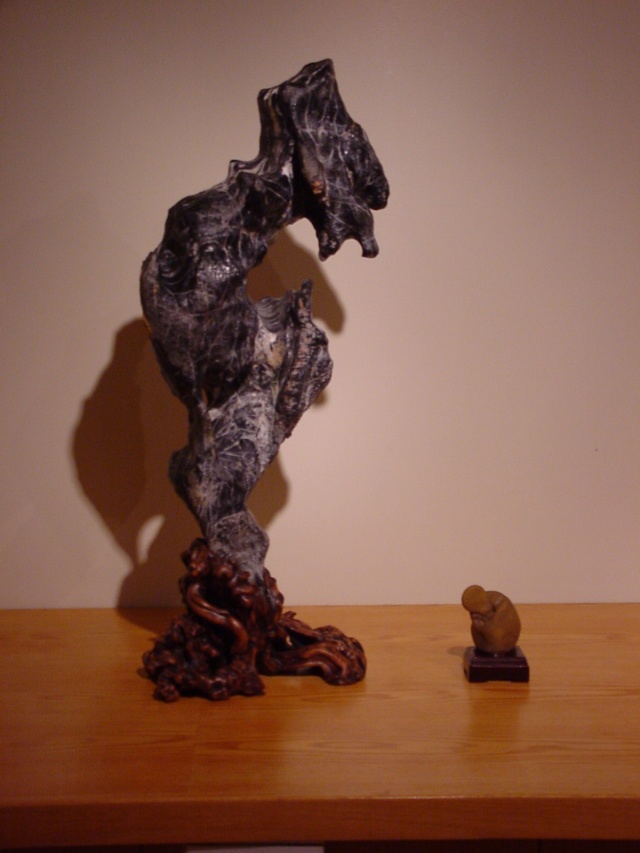
Burnished mountain

"Sage viewing distant scene" pattern (or "Rearing horse" pattern)

Large Daruma stone clothed in root (literati/sencha taste)
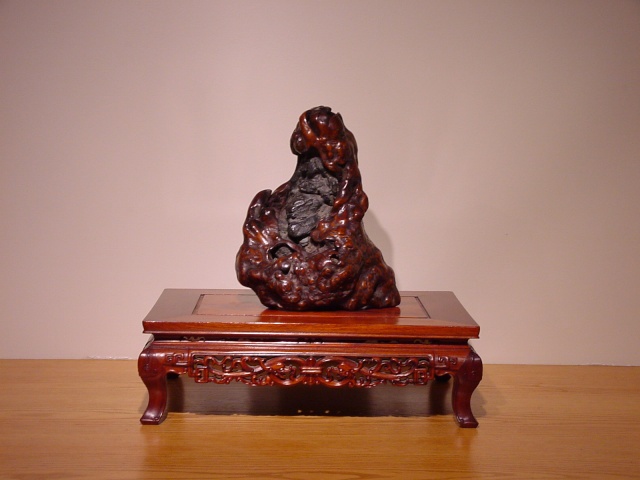
Projecting cliff

(Exhibit photo blurred, from Exhibit preview):
Rugged coastal rocks, 35" marble tray
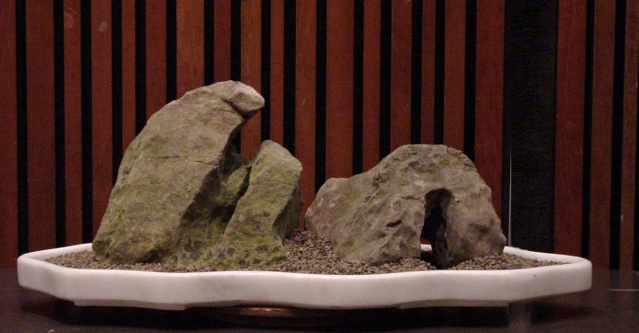
Chinese "Mohu stone"

Two-step, projecting cliff
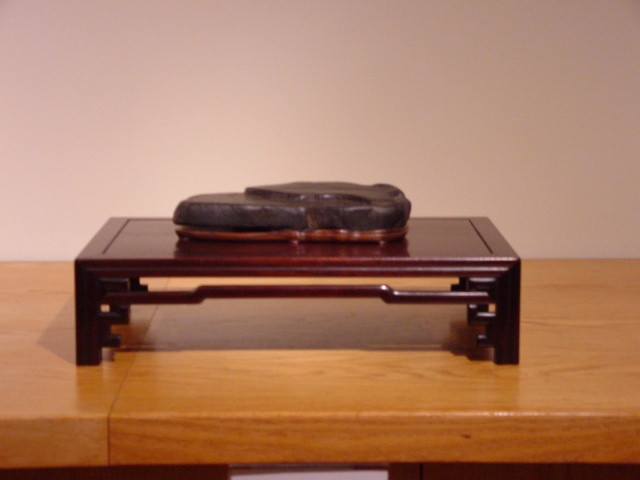
Multi-tier arrangement including Lightening pattern, High plateau & Hut stones
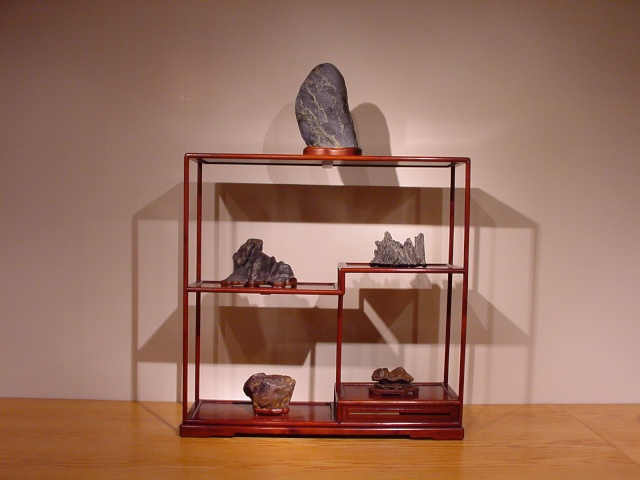
Lightening pattern, High plateau, Hut (closer view)

The "Flowering Cherry Tree" pattern stone shown earlier with the carved ox okimono was placed, here, in the exhibit (see earlier illustration). It was arguably the club's most interesting display. The barest blush color of the stone matched pink highlights in the wild cherry-wood socketed board on which the stone was balanced. Brilliant. Similar artistic display by Mas Nakajima has been appreciated in club meetings. This West Virginia collector Nan Morgan found both the stone and the board-stand which she crafted in her local area.
The last stone on the central table (in a keystone position) was large. It (arguably) flows visually toward the table's center
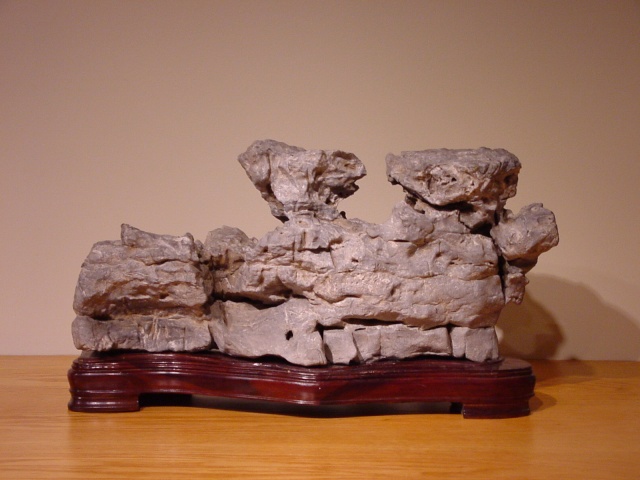

Burnished mountain

"Sage viewing distant scene" pattern (or "Rearing horse" pattern)

Large Daruma stone clothed in root (literati/sencha taste)

Projecting cliff

(Exhibit photo blurred, from Exhibit preview):
Rugged coastal rocks, 35" marble tray

Chinese "Mohu stone"

Two-step, projecting cliff

Multi-tier arrangement including Lightening pattern, High plateau & Hut stones

Lightening pattern, High plateau, Hut (closer view)

The "Flowering Cherry Tree" pattern stone shown earlier with the carved ox okimono was placed, here, in the exhibit (see earlier illustration). It was arguably the club's most interesting display. The barest blush color of the stone matched pink highlights in the wild cherry-wood socketed board on which the stone was balanced. Brilliant. Similar artistic display by Mas Nakajima has been appreciated in club meetings. This West Virginia collector Nan Morgan found both the stone and the board-stand which she crafted in her local area.
The last stone on the central table (in a keystone position) was large. It (arguably) flows visually toward the table's center

Last edited by Chris Cochrane on Sat Jan 17, 2009 12:12 am; edited 1 time in total

Chris Cochrane- Member
 Re: PVSG exhibit walk-thru
Re: PVSG exhibit walk-thru
Thank you for sharing, Chris. You are quite privileged to live so near to our national collection.
You wrote, "Bamboo & Plum stones, Pine cone kogo "incense container:" Three Friends of Winter (Chinese allusion)". These do, indeed, have their roots in Chinese tradition, but sho-chiku-bai is also a very Japanese tradition. Literally translated sho-chiku-bai means pine-bamboo-plum, and these three plants form the basis of a New Year's group planting which represents to the Japanese people evergreen stability (long life), upright behavior (virtue) and happiness. To these three basic plants are added miniature bamboo (sasa), the red berried ardisia (yabukoji), nandina (nanten), and the Japanese wild orchid (shunran), two rocks, white pebble and moss. You can read about it in THE JAPANESE ART OF MINIATURE TREES AND LANDSCAPES by Yuji Yoshimura and G. M. Halford (p. 139).
You wrote, "Bamboo & Plum stones, Pine cone kogo "incense container:" Three Friends of Winter (Chinese allusion)". These do, indeed, have their roots in Chinese tradition, but sho-chiku-bai is also a very Japanese tradition. Literally translated sho-chiku-bai means pine-bamboo-plum, and these three plants form the basis of a New Year's group planting which represents to the Japanese people evergreen stability (long life), upright behavior (virtue) and happiness. To these three basic plants are added miniature bamboo (sasa), the red berried ardisia (yabukoji), nandina (nanten), and the Japanese wild orchid (shunran), two rocks, white pebble and moss. You can read about it in THE JAPANESE ART OF MINIATURE TREES AND LANDSCAPES by Yuji Yoshimura and G. M. Halford (p. 139).
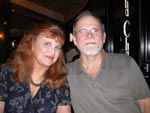
Alan Walker- Member
 Re: PVSG exhibit walk-thru
Re: PVSG exhibit walk-thru
A-a-h, more wonderful stones 
And a couple more questions:
The "large Daruma stone clothed in root"... is it totally imbedded in the root? I wish we could see the stone more clearly. Fantastic!!
The stone you label "two-step projecting cliff"...could it not also be labeled a step-plateau ?
Thanks, Chris
P.S. I hope you don't miss my first reply with this unwieldy "newest first order".
And a couple more questions:
The "large Daruma stone clothed in root"... is it totally imbedded in the root? I wish we could see the stone more clearly. Fantastic!!
The stone you label "two-step projecting cliff"...could it not also be labeled a step-plateau ?
Thanks, Chris
P.S. I hope you don't miss my first reply with this unwieldy "newest first order".

Norma- Member
 Re: PVSG exhibit walk-thru
Re: PVSG exhibit walk-thru
Hi Norma... Sorry to not respond immediately after your post-- I did not wish to lose continuing work on photos of stones on the center table (should be added & another table-full... if I can manage it). You graciously write:
> Having said this, I really hesitate to give critique of any weakness in a display...
Please critique it. There is much that I don't particularly like. With only a few hours to unload, mount and tag stones, several club officers each contributed with their own ideas in separate, non-contiguous arrangements. We also listened to owners preferences to accommodate them as stones, stands and accessories were delivered. Sometimes a poorly sized stand is mated with a stone because it was the owner's preference, and we would have to dip into Museum stands (in addition to the multi-tier stands already supplied). While we have large stands, packing/transporting them from distance over a hundred miles away takes valuable space for packing stones & many smaller stands, boards, accessories.
I noted on another forum (the old VSL list, now a Yahoo group) that one club officer referred to the exhibit coordinators as "three grandmothers." He wasn't referring to our warmth, I think, but suggesting we were each "fiddly & picky" in ways that our individual experiences have promoted. We respect & accommodate each other-- especially where feeling is strong. Another coordinator & I were at odds over a board (or stand) under the "Turtle" stone. A lightly-rusted iron, wood-range burner top (handle depression filled with wax & patinated) was preferred by the stone's owner & won-the-day. I liked it.
Our thought with the first table was to beginning focus on "complimentary wishes for rising expectations"-- typical of arrangements created for the New Year season. The center table was to focus on deep winter-- especially landscapes. Approaching the last table would be faint hints of Spring.
What coordinators knew from previous exhibits is that there are keystone spots for appreciating the best (especially if large) stones. The end of the entry-aisle (so you see this stone from distance upon entering) is the most revered position (Marked "1")-- it helps if the chosen arrangement has visual flow in the direction where the next table continues the exhibit. The second best position is turning from the entry aisle with the center (longest table at your left) and seeing an important stone in the distant end of that aisle. The next important keystone positions are perhaps the first closely-viewed stone in the exhibit, which must strongly drive the visual flow into the exhibit & away from mechanical works on the wall ending the exhibit space.
If a higher stand is used with the stone in the center of the central table, it can be an important position (Marked "4"); following Mr. Kato's death, this was used to advantage to highlight a suiseki gift from him to the Director of the National Arboretum Dr. Tom Elias. Other keystone positions are noted in leaving the exhibit space (Marked "X," twice).
National Bonsai & Penjing Museum (note entrance/exit arrows)

> My favorite display is "Dreaming of Sun Over the Sea".....the sleeping figure
> is perfect with this stone.
Though not traditional in today's canon, it expresses a certain feeling for atmosphere that was intended to open the scene. Originally, I brought many items which were not necessarily stones to suggest the New Year's dream, First Sighting (bird: the swallow, flower: plum or camelia et al.), longevity or health/prosperity/luck, Fujisan, Rising-sun-over-sea et al.). We decided to use them sparingly for more elegance & less pompous display. We needed open space to best highlight stones.
> I also was "taken" with the bird figure and nontraditional display of woodblock
> winter street scene.
Upon reflection (& its my assumption that the stone is a bird), I think I would reverse the the two objects so that the bird looks back over its wing in the general direction of the woodblock print. Better yet, the print could hang on the wall to further the dominate bird gaze. The intense gaze of birds in some Japanese art recalls capture of a single fleeting moment-- often before a raptor (hawk) strikes prey.
> The Mt. Fuji stone is wonderful but I'd like to see it in a larger flatter suiban...
> but perhaps this is a deep uncut stone ??
It is a deep, uncut stone from a very new collector. I was very happy to see such a nice pot & well-chosen sand, which he had only recently matched with the stone. We "added" the very apt image which wasn't available weeks before. i don't think Brian is a bonsai enthusiast, either. He is bowling the club over with interesting stones & personally developed techniques for preparing them. Sometimes, I prefer a little awkward match if created by a stones owner. Perfected images are not as likely to be emotionally moving. I asked that one stone requested from me not be displyed nbecause it is too "classical." Another coordinator selected it over a better choice (to my mind) and I did not fight his preference.
> A question: in a recent juried show our bonsai club hosted, an exhibit of a large
> stone with scroll and small stone as accent was critiqued as nontraditional
> because of the choice of another stone as an accent. Is this a correct
> assessment?
It is accurate from my experience for suiseki display, but as you can see, PVSG members have chosen similar stone matching in our viewing stone exhibit-- e.g., Daruma staring at the Cave Wall, Mi Fu bowing to a Rock. Suiseki & bonsai should not be displayed together as principal and major accessory objects in Keido (intimate, alcove-style display). In multi-tier shohin display (accessory or exhibit space) as well as in full-sized exhibit display (e.g., Kokufuten, Tokyo), options exists for placing stones and bonsai together. In some instances, distinguishing other stones as accessories opposed to landscape-view suiseki is traditional.
I'm a student as you are, Norma. Check the display choices you admire. In the Taikanten (Kyoto), the conventions of display by practioners in Tokyo might be thoroughly avoided. Morten Albek has shared the vastly different quality of shohin displays seen at the prestigious Gafuten (shohin bonsai exhibit, Kyoto). The feeling expressed or strangled by sharing space is better to understand and appreciate than judging by technique.
I'm sure Jerry puts a lot of thought into his public displays. It distracts me to see repeated placement of principal display objects further from a scroll than the first accessory object, but that need not ruin the expression. Jerry often places the scroll considerably off-center when space seems adequate for more central placement. It is something he has learned or feels will heighten his display. I wonder why, but it isn't a broken rule which requires adherence. Feeling can only come from openness to the designer's expression. It helps if you trust the designer of the arrangement to choose in taste you can share. Cultivating an audience is very important for art to thrive.
> Having said this, I really hesitate to give critique of any weakness in a display...
Please critique it. There is much that I don't particularly like. With only a few hours to unload, mount and tag stones, several club officers each contributed with their own ideas in separate, non-contiguous arrangements. We also listened to owners preferences to accommodate them as stones, stands and accessories were delivered. Sometimes a poorly sized stand is mated with a stone because it was the owner's preference, and we would have to dip into Museum stands (in addition to the multi-tier stands already supplied). While we have large stands, packing/transporting them from distance over a hundred miles away takes valuable space for packing stones & many smaller stands, boards, accessories.
I noted on another forum (the old VSL list, now a Yahoo group) that one club officer referred to the exhibit coordinators as "three grandmothers." He wasn't referring to our warmth, I think, but suggesting we were each "fiddly & picky" in ways that our individual experiences have promoted. We respect & accommodate each other-- especially where feeling is strong. Another coordinator & I were at odds over a board (or stand) under the "Turtle" stone. A lightly-rusted iron, wood-range burner top (handle depression filled with wax & patinated) was preferred by the stone's owner & won-the-day. I liked it.
Our thought with the first table was to beginning focus on "complimentary wishes for rising expectations"-- typical of arrangements created for the New Year season. The center table was to focus on deep winter-- especially landscapes. Approaching the last table would be faint hints of Spring.
What coordinators knew from previous exhibits is that there are keystone spots for appreciating the best (especially if large) stones. The end of the entry-aisle (so you see this stone from distance upon entering) is the most revered position (Marked "1")-- it helps if the chosen arrangement has visual flow in the direction where the next table continues the exhibit. The second best position is turning from the entry aisle with the center (longest table at your left) and seeing an important stone in the distant end of that aisle. The next important keystone positions are perhaps the first closely-viewed stone in the exhibit, which must strongly drive the visual flow into the exhibit & away from mechanical works on the wall ending the exhibit space.
If a higher stand is used with the stone in the center of the central table, it can be an important position (Marked "4"); following Mr. Kato's death, this was used to advantage to highlight a suiseki gift from him to the Director of the National Arboretum Dr. Tom Elias. Other keystone positions are noted in leaving the exhibit space (Marked "X," twice).
National Bonsai & Penjing Museum (note entrance/exit arrows)

> My favorite display is "Dreaming of Sun Over the Sea".....the sleeping figure
> is perfect with this stone.
Though not traditional in today's canon, it expresses a certain feeling for atmosphere that was intended to open the scene. Originally, I brought many items which were not necessarily stones to suggest the New Year's dream, First Sighting (bird: the swallow, flower: plum or camelia et al.), longevity or health/prosperity/luck, Fujisan, Rising-sun-over-sea et al.). We decided to use them sparingly for more elegance & less pompous display. We needed open space to best highlight stones.
> I also was "taken" with the bird figure and nontraditional display of woodblock
> winter street scene.
Upon reflection (& its my assumption that the stone is a bird), I think I would reverse the the two objects so that the bird looks back over its wing in the general direction of the woodblock print. Better yet, the print could hang on the wall to further the dominate bird gaze. The intense gaze of birds in some Japanese art recalls capture of a single fleeting moment-- often before a raptor (hawk) strikes prey.
> The Mt. Fuji stone is wonderful but I'd like to see it in a larger flatter suiban...
> but perhaps this is a deep uncut stone ??
It is a deep, uncut stone from a very new collector. I was very happy to see such a nice pot & well-chosen sand, which he had only recently matched with the stone. We "added" the very apt image which wasn't available weeks before. i don't think Brian is a bonsai enthusiast, either. He is bowling the club over with interesting stones & personally developed techniques for preparing them. Sometimes, I prefer a little awkward match if created by a stones owner. Perfected images are not as likely to be emotionally moving. I asked that one stone requested from me not be displyed nbecause it is too "classical." Another coordinator selected it over a better choice (to my mind) and I did not fight his preference.
> A question: in a recent juried show our bonsai club hosted, an exhibit of a large
> stone with scroll and small stone as accent was critiqued as nontraditional
> because of the choice of another stone as an accent. Is this a correct
> assessment?
It is accurate from my experience for suiseki display, but as you can see, PVSG members have chosen similar stone matching in our viewing stone exhibit-- e.g., Daruma staring at the Cave Wall, Mi Fu bowing to a Rock. Suiseki & bonsai should not be displayed together as principal and major accessory objects in Keido (intimate, alcove-style display). In multi-tier shohin display (accessory or exhibit space) as well as in full-sized exhibit display (e.g., Kokufuten, Tokyo), options exists for placing stones and bonsai together. In some instances, distinguishing other stones as accessories opposed to landscape-view suiseki is traditional.
I'm a student as you are, Norma. Check the display choices you admire. In the Taikanten (Kyoto), the conventions of display by practioners in Tokyo might be thoroughly avoided. Morten Albek has shared the vastly different quality of shohin displays seen at the prestigious Gafuten (shohin bonsai exhibit, Kyoto). The feeling expressed or strangled by sharing space is better to understand and appreciate than judging by technique.
I'm sure Jerry puts a lot of thought into his public displays. It distracts me to see repeated placement of principal display objects further from a scroll than the first accessory object, but that need not ruin the expression. Jerry often places the scroll considerably off-center when space seems adequate for more central placement. It is something he has learned or feels will heighten his display. I wonder why, but it isn't a broken rule which requires adherence. Feeling can only come from openness to the designer's expression. It helps if you trust the designer of the arrangement to choose in taste you can share. Cultivating an audience is very important for art to thrive.

Chris Cochrane- Member
 Re: PVSG exhibit walk-thru
Re: PVSG exhibit walk-thru
Hi Alan... That Yuji referenced Shochikubai as a Japanese tradition without noting Chinese origin is consistent with his chafing at Chinese authors claiming their country was largely responsible for bonsai development. Yuji Yoshimura's father followed Japanese literati artistic tradition in an age later than most practicing literatus, but Yuji's writing does little to acknowledge Chinese spirit that flavors bonsai through Japanese literati influence. Modern artistic bonsai practice is largely a result of Japanese practitioners enthusiastically carrying forward the spirit of Chinese landscape art & culture.
Shochikubai grouping is not native to Japan as a seasonal New Year tradition though practiced in Japan with native Japanese embellishment.
Hi Norma...
Another view of the Daruma stone

> The stone you label "two-step projecting cliff"...could it not also be labeled a step-plateau ?
You can call it what you wish. I'm not sure what Tom Elias (the stone's owner) requested on the Museum tag. A "plateau or slope" stone (doha-ishi) traditionally has a pointed or rounded top with a long slope or plateau reaching to a distant peak & with a well-defined edge at the peak's bottom. A "step or stepped-cascade" stone (danseki)has a flat top with preferably two or more additional lower steps that increase in area. This is not a classical doha-ishi or danseki.
This stone projects with a flat bottom extending from front to back above its daiza along a significant portion of the stone's length extending toward the left. The stone also has a nice dry waterfall descending from its lower step.
Elias stone in earlier exhibit (original photo's shadows are lightened)

Multiple object-form classifications are sometimes used to describe a stone with more than one attribute, but not commonly. I agree with not limiting a stone by noting its object classification (see debates in CA Aiseki Kai newsletters, too) for their public exhibits, but it is common practice in the USA to state a prominant landscape contour.
I recall a "sandan doha-ishi" in Suiseki: an Art Created by Nature. To me this is niggling to the point of losing meaning, though I could understand the conflicting choice. Enjoy the beautiful stone. I think you will tire faster of the perfected example.
Shochikubai grouping is not native to Japan as a seasonal New Year tradition though practiced in Japan with native Japanese embellishment.
Hi Norma...
Another view of the Daruma stone

> The stone you label "two-step projecting cliff"...could it not also be labeled a step-plateau ?
You can call it what you wish. I'm not sure what Tom Elias (the stone's owner) requested on the Museum tag. A "plateau or slope" stone (doha-ishi) traditionally has a pointed or rounded top with a long slope or plateau reaching to a distant peak & with a well-defined edge at the peak's bottom. A "step or stepped-cascade" stone (danseki)has a flat top with preferably two or more additional lower steps that increase in area. This is not a classical doha-ishi or danseki.
This stone projects with a flat bottom extending from front to back above its daiza along a significant portion of the stone's length extending toward the left. The stone also has a nice dry waterfall descending from its lower step.
Elias stone in earlier exhibit (original photo's shadows are lightened)

Multiple object-form classifications are sometimes used to describe a stone with more than one attribute, but not commonly. I agree with not limiting a stone by noting its object classification (see debates in CA Aiseki Kai newsletters, too) for their public exhibits, but it is common practice in the USA to state a prominant landscape contour.
I recall a "sandan doha-ishi" in Suiseki: an Art Created by Nature. To me this is niggling to the point of losing meaning, though I could understand the conflicting choice. Enjoy the beautiful stone. I think you will tire faster of the perfected example.
Last edited by Chris Cochrane on Thu Feb 19, 2009 7:15 pm; edited 2 times in total

Chris Cochrane- Member
 Re: PVSG exhibit walk-thru
Re: PVSG exhibit walk-thru
Thanks for your very informative response, Chris. You are quite right to point out the influence of prejudice in the writing of history by Yuji and many, many others. I do want to point out that nothing was said about sho-chiku-bai being native to Japan. What was said was, "These do, indeed, have their roots in Chinese tradition, but sho-chiku-bai is also a very Japanese tradition."Chris Cochrane wrote:Shochikubai grouping is not native to Japan as a seasonal New Year tradition though practiced in Japan with native Japanese embellishment.
I have a question about those stones. What about the stones distinguishes them as plum or bamboo? This was not clear to me from the photo, and without your commentary, I would have totally missed that connection.

Alan Walker- Member
 Re: PVSG exhibit walk-thru
Re: PVSG exhibit walk-thru
Hi Alan...
PVSG collector Daniel Bui gave two garden "bamboo stones" to the Museum (both now planted outside the Yoshimura Center). There is another bamboo pattern stone in the exhibit of considerable quality (on the third table & not yet illustrated). An exhibit coordinator had expressly requested this stone for the exhibit. Taste varies, but having an exceptionally tall stone to "stop the eye" at one end of the exhibit was fortunate for exhibit arrangement.
You can see vertically repeated patterns (like bamboo-root patterns) throughout the green matrix

A closer view of the Japanese "Plum (ume) pattern" stone

PVSG collector Daniel Bui gave two garden "bamboo stones" to the Museum (both now planted outside the Yoshimura Center). There is another bamboo pattern stone in the exhibit of considerable quality (on the third table & not yet illustrated). An exhibit coordinator had expressly requested this stone for the exhibit. Taste varies, but having an exceptionally tall stone to "stop the eye" at one end of the exhibit was fortunate for exhibit arrangement.
You can see vertically repeated patterns (like bamboo-root patterns) throughout the green matrix

A closer view of the Japanese "Plum (ume) pattern" stone

Last edited by Chris Cochrane on Sun Feb 22, 2009 12:41 am; edited 1 time in total

Chris Cochrane- Member
 Stones on Third Table (last section of exhibit)
Stones on Third Table (last section of exhibit)
The Last table began with a bamboo-pattern stone. To shorten the number of photos, I've paired individual stones, a multi-tiered arrangement & a natural root into pairs that are much closer than they occur in the actual exhibit. I'll be interested if the merged photo effect for posting. You might note individual objects are separately shot in front of their horizontal center rather than both objects in a photo focused from the same original point.
Bamboo-pattern stone & multi-tier arrangement

Chinese stones of different character

Perhaps a rabbit in its late-winter coat
https://i.servimg.com/u/f34/13/44/48/20/rabbit10.jpg[/img]
Natural root sculpture & Teabowl-shaped stone

Peony-pattern stone (near the size of a basketball) ending the exhibit
 [img]
[img]
Bamboo-pattern stone & multi-tier arrangement

Chinese stones of different character

Perhaps a rabbit in its late-winter coat
https://i.servimg.com/u/f34/13/44/48/20/rabbit10.jpg[/img]
Natural root sculpture & Teabowl-shaped stone

Peony-pattern stone (near the size of a basketball) ending the exhibit
 [img]
[img]Last edited by Chris Cochrane on Fri Jan 30, 2009 7:44 pm; edited 1 time in total (Reason for editing : missed stone added to exhibit after original photos)

Chris Cochrane- Member
 Similar topics
Similar topics» No Holes Barred- the annual PVSG Exhibit
» American Stone Appreciation-- a PVSG exhibit in Washington DC
» PVSG Exhibit: Legacy of Japanese Suiseki in North America
» Viewing Stone's of North America: An Emerging Perspective-- the annual PVSG exhibit
» A walk in the woods
» American Stone Appreciation-- a PVSG exhibit in Washington DC
» PVSG Exhibit: Legacy of Japanese Suiseki in North America
» Viewing Stone's of North America: An Emerging Perspective-- the annual PVSG exhibit
» A walk in the woods
Page 1 of 1
Permissions in this forum:
You cannot reply to topics in this forum






